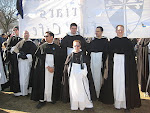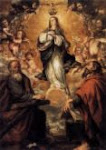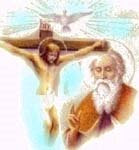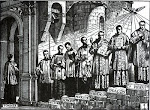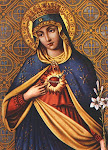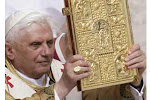 Venta was a large and beautiful Roman city as was Caerleon, but the latter was a fort and not a Roman city, totally different to most other town dwellings or 'Trefs' in Gwent.
Venta was a large and beautiful Roman city as was Caerleon, but the latter was a fort and not a Roman city, totally different to most other town dwellings or 'Trefs' in Gwent.Their way of life was as the court was, Christian and the Irish priest Tathyws who was brought to Sudbrook on a small boat with twelve of his disciples, was the core of the Christian life and pattern of festivals and holidays. Tathyws was responsible for educating the royal princes of Glysyssing, Cadoc, Cyfyw, Cynydr and also their sister Maches who was foully murdered while tending the sheep.
Madrun must have gravitated towards Tathyws. Kindly and holy, he was a gifted teacher and priest. She was especially drawn to the teaching of St Augustine, the teaching which said that after their husbands death, widows could take the veil and become consecrated Widows as well as women, who were elderly and past child bearing age, who could also take the place of holy matrons. In this way they could embrace martyrdom, not of the 'red' or bloody type. This was called a White Martyrdom, where the Christian leaves all their security and all they hold dear and puts themselves outside the security system of the llan. The White Martyrdom was also usually preceded by a pellegrinatio ,where the would be Martyr (Welsh 'Merthyr') would embark on some sort of test, often by setting off on a boat on the sea to see where the boat would take him, should the Christian be worthy to be spared death of the sea, that was where God wanted him or her to be. Sometimes this journey would take place on land, until a sign from God would come and a new llan would be set up. It was often royal people who took the lead in this, having the means and the manpower to set about something like this. The gifts of land and farms necessary to support such llans could only be realised by people with some wealth. In the case of Ynyr, he granted land and a monastery to St Tathyws.
Having a monastery in the Roman town was a kind of social services. The Vita Tathei says that Ynyr provided part of his own palace for the monks to reside in and moved elsewhere. Although the monks main job was to pray for the world, they worked hard in manual labour in the field, and provided a school , counsel and wrote records for the King and Queen, and writing letters and deeds.They often took in orphans and fed the poor in harsh winters and famines.
In particular, Tathyws was the kindly father Abbot, who replaced her own beloved father Vortimer the Blessed and he was a big support to the traumatised woman and a wise spiritual counsellor.
______________________________________________________________________




